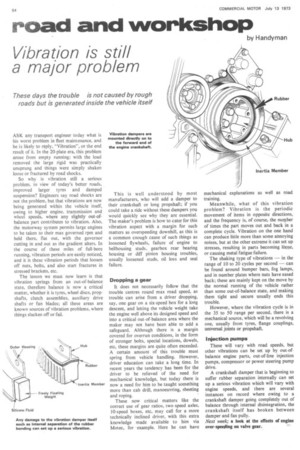road and workshop
Page 56

If you've noticed an error in this article please click here to report it so we can fix it.
by Handyman
Vibration is still a major problem
These days the trouble is not caused by rough roads but is generated inside the vehicle itself
ASK any transport engineer today what is his worst problem in fleet maintenance, and he is likely to reply, "Vibration", or the end result of it. In the 20-plate era, this problem arose from empty running; with the load removed the large rigid was practically unsprung and things were simply shaken loose or fractured by road shocks.
So why, is vibration still a serious problem, in view of today's better roads, improved larger tyres and damped suspension? Engineers say road shocks are not the problem, but that vibrations are now being generated within the vehicle itself, owing to higher engine, transmission and wheel speeds, where any slightly out-ofbalance part contributes to vibration. Also, the motorway system permits large engines to be taken to their max governed rpm and held there, flat out, with the governor cutting in and out as the gradient alters. In the course of these miles of full-bore running, vibration periods are easily noticed, and it is these vibration periods that loosen off nuts, bolts, and also start fractures in stressed brackets, etc.
The lesson we must now learn is that vibration springs from an out-of-balance state, therefore balance is now a critical matter, whether it is tyres, wheel discs, propshafts, clutch assemblies, auxiliary drive shafts or fan blades; all these areas are known sources of vibration problems, where things slacken off or fail. This is well understood by most manufacturers, who will add a damper to their crankshaft or long propshaft; if you could take a ride without these dampers you would quickly see why they are essential. The maker's problem is how to cater for this vibration aspect with a margin for such matters as overspeeding downhill, as this is a common enough cause of such things as loosened flywheels, failure of engine to bellhousing studs, gearbox rear bearing housing or diff pinion housing troubles, usually loosened studs, oil loss and seal failure.
Dropping a gear It does not necessarily follow that the trouble centres round max road speed, as trouble can arise from a driver dropping, say, one gear on a six-speed box for a long descent, and letting the vehicle weight take the engine well above its designed speed and into a critical out-of-balance area where the maker may not have been able to add a safeguard. Although there is a margin covered for overrun conditions, in the form of stronger bolts, special locations, dowels, etc, these margins are quite often exceeded. A certain amount of this trouble must spring from vehicle handling. However, driver education can take a long time. In recent years the tendency has been for the driver to be relieved of the need for mechanical knowledge, but today there is now a need for him to be taught something more than cab drill, manoeuvring, sheeting and roping.
These now critical matters like the correct use of gear ratios, two-speed axles, 10-speed boxes, etc, may call for a more technically inclined driver, with this extra knowledge made available to him via Motec, for example. Here he can have mechanical explanations as well as road training.
Meanwhile, what of this vibration problem? Vibration is the periodic movement of items in opposite directions, and the frequency is, of course, the number of times the part moves out and back in a complete cycle. Vibration on the one hand can produce little more than some annoying noises, but at the other extreme it can set up stresses, resulting in parts becoming 100,se, or causing metal fatigue failure.
The shaking type of vibrations — in the range of 10 to 20 cycles per second — can be found around bumper bars, fog lamps, and in number plates where nuts have eased back; these are mainly kept on the move by the normal running of the vehicle rather than some out-of-balance state, and making them tight and secure usually ends this trouble.
However, where the vibration cycle is in the 35 to 50 range per second, there is a mechanical source, which will be a revolving one, usually from tyres, flange couplings, universal joints or propshaft.
Injection pumps
These will vary with road speeds, but other vibrations can be set up by out-ofbalance engine parts, out-of-line injection pumps, compressor or power steering pump drive.
A crankshaft damper that is beginning to suffer rubber separation internally can set up a serious vibration which will vary with engine speeds, and there are several instances on record where owing to a crankshaft damper going completely out of balance through internal disintegration, the crankshaft itself has broken between damper and fan pully.
Next week; a look at the effects of engine
over-speeiling on valve gear. ,2.
































































































